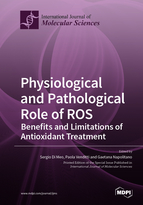Physiological and Pathological Role of ROS: Benefits and Limitations of Antioxidant Treatment
A special issue of International Journal of Molecular Sciences (ISSN 1422-0067). This special issue belongs to the section "Molecular Biology".
Deadline for manuscript submissions: closed (30 June 2019) | Viewed by 75495
Special Issue Editors
Interests: ROS; oxidative stress; antioxidants; exercise; hyperthyroidism; diabetes; mitochondria
Special Issues, Collections and Topics in MDPI journals
Interests: ROS; oxidative stress; mitochondria; antioxidants; ischemia–reperfusion; functional and experimental hyperthyroidism; exercise; hyperthyroidism; diabetes
Special Issues, Collections and Topics in MDPI journals
Interests: oxidative stress; fish physiology; endurance; ROS; environmental pollution; mitochondria
Special Issues, Collections and Topics in MDPI journals
Special Issue Information
Dear colleagues,
ROS were long considered one of the key players in tissue injury. Indeed, overproduction of ROS results in oxidative stress, a process leading to the development of many pathological conditions for whose treatment the use of antioxidants was proposed.
Over time, it was shown that ROS at low concentrations act as signaling molecules leading to the regulation of physiological functions. Moreover, several interventions that increase ROS generation activate stress-adaptive responses that extend lifespan. It was also shown that excessive use of antioxidants can counter the beneficial effects of ROS.
Currently, much progress has been made in understanding the role of ROS in human diseases and ageing as well as in the regulation of physiological functions, and in identifying the signaling pathways involved in ROS. However, much remains to be understood about the mutual interactions among signaling pathways underlying organism-adaptive responses, their modifications (which occur during ageing), and some disease states. For this reason, we invite you to submit original research articles and reviews that address the effects of ROS production and antioxidant treatment in living organisms, focusing on their impact on health, diseases, and ageing.
Prof. Dr. Sergio Di Meo
Prof. Dr. Paola Venditti
Dr. Gaetana Napolitano
Guest Editors
Manuscript Submission Information
Manuscripts should be submitted online at www.mdpi.com by registering and logging in to this website. Once you are registered, click here to go to the submission form. Manuscripts can be submitted until the deadline. All submissions that pass pre-check are peer-reviewed. Accepted papers will be published continuously in the journal (as soon as accepted) and will be listed together on the special issue website. Research articles, review articles as well as short communications are invited. For planned papers, a title and short abstract (about 100 words) can be sent to the Editorial Office for announcement on this website.
Submitted manuscripts should not have been published previously, nor be under consideration for publication elsewhere (except conference proceedings papers). All manuscripts are thoroughly refereed through a single-blind peer-review process. A guide for authors and other relevant information for submission of manuscripts is available on the Instructions for Authors page. International Journal of Molecular Sciences is an international peer-reviewed open access semimonthly journal published by MDPI.
Please visit the Instructions for Authors page before submitting a manuscript. There is an Article Processing Charge (APC) for publication in this open access journal. For details about the APC please see here. Submitted papers should be well formatted and use good English. Authors may use MDPI's English editing service prior to publication or during author revisions.
Keywords
- ROS
- Antioxidants
- Health
- Disease
- Aging
- Redox homeostasis
- Redox signaling
- Antioxidant supplementation.









